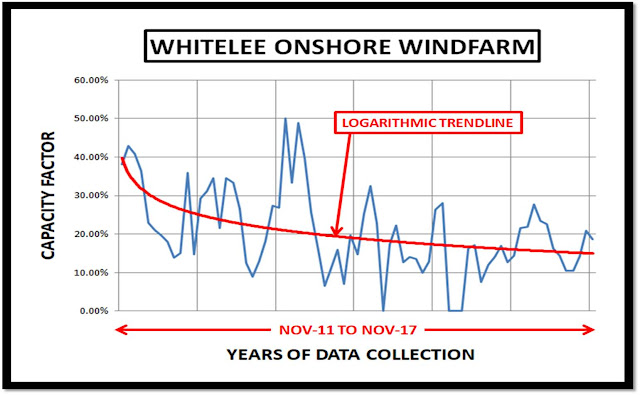Scottish
Power still publicise that Whitelee Windfarm has an “…average capacity factor of 27%...” – But this
is the reality of metered generation:
The
trendline, as of Nov 17, is down at about 15% and STILL trending downwards. That’s
not capable of generating enough electricity to power “…*298,837 homes per year…”,
it’s only generating enough to power 166,021 homes per year.
--------------------//--------------------
Wind farms were paid more than £100 million in
2017 to switch off their turbines. Astonishingly, windfarms receive on average
40 per cent more when switched off than when they are generating electricity.The
National Grid pay the windfarms, but it is added to electricity bills of
consumers.
--------------------//--------------------
Scottish
Power are, today, quoting a generating ‘capability’ for Whitelee Windfarm which
is 80% in excess of metered reality !!!
--------------------//--------------------
“…The topography
of the area is of a relatively flat plateau with occasional hills rising
above the flatter plateau landmass, all of which is overlain with deep peat, in
some places reaching down past 8 meters………. No-one knows exactly when
blanket bogs began to form but its accepted that it was somewhere between
6000 and 9000 years ago…”
IT'S FAIR TO SAY THE SITE OF WHITELEE WINDFARM WAS UNDEGRADED PEATLANDS !
--------------------//--------------------
“…Here we show
that, whereas in 2010, most [undegraded peatlands] sites had potential to
provide net carbon savings, by 2040 most sites will not reduce carbon emissions
even with careful management. This is due to projected changes in the
proportion of fossil fuels used to generate electricity.
THE RESULTS SUGGEST FUTURE POLICY SHOULD AVOID
CONSTRUCTING WIND FARMS ON UNDEGRADED PEATLANDS unless drainage of peat is
minimal and:
THE VOLUME
EXCAVATED IN FOUNDATIONS CAN BE SIGNIFICANTLY REDUCED COMPARED TO ENERGY OUTPUT…”
--------------------//--------------------
This
paper was published just 3 years after Whitelee commenced operation, following
the excavation and muck-spreading of 850,000 m3 of undegraded
peatland (ancient - 6,000 to 9,000 years old - blanket peat bog).
--------------------//--------------------
In addition, 2,500,000 tonne of stone was
quarried for roads and turbine bases; 120,000 tonne of concrete was used;
2,250,000 non-native conifer trees [900 hectares] were removed; 300 hectares of
spruce trees were removed.
--------------------//--------------------
The raison
d'être for windfarms is to save greenhouse gas emissions. Was Whitelee worth it
when its Capacity Factor was 27%?
DOUBTFUL !!!
Now
its Capacity Factor is 15% - WHAT’S THE POINT ?
WHAT
IS THE POINT
!!!!
------------------------------//------------------------------
Whitelee
would not pay back its Carbon Debt if it operated for 100 years!!!
But
its lifespan may only be 20 years -
25 years at the most.
How
many more onshore windfarms are worsening our greenhouse gas emission, when we
are paying through the nose for them to supposedly improve matters???







